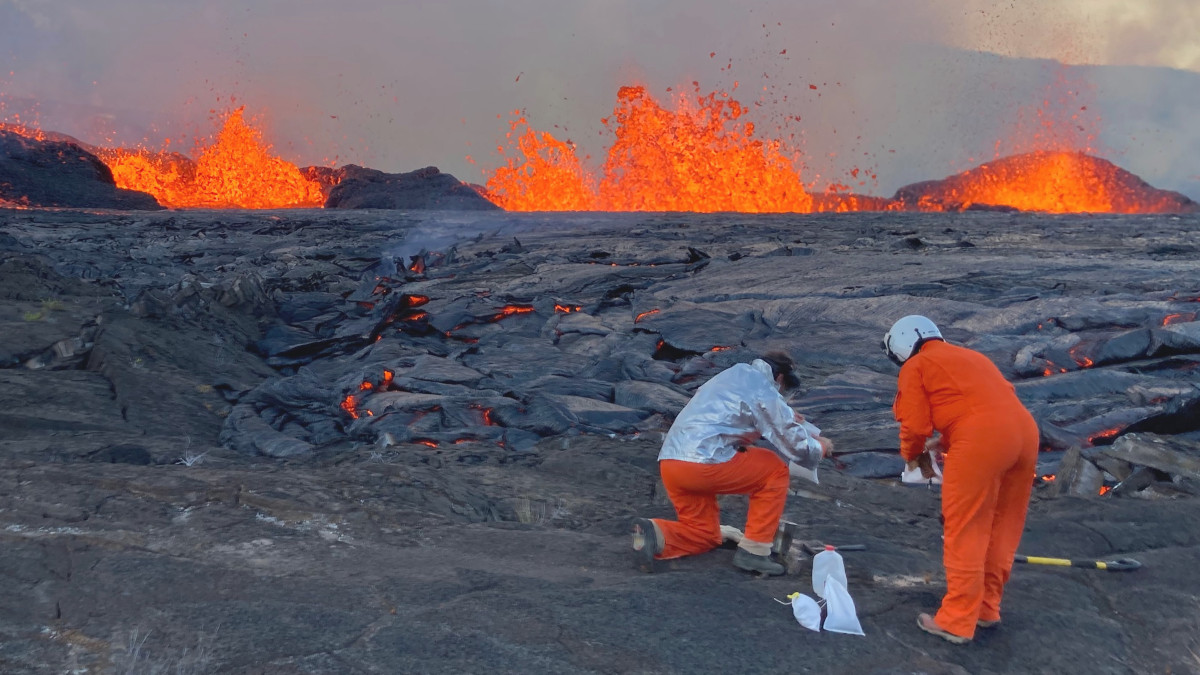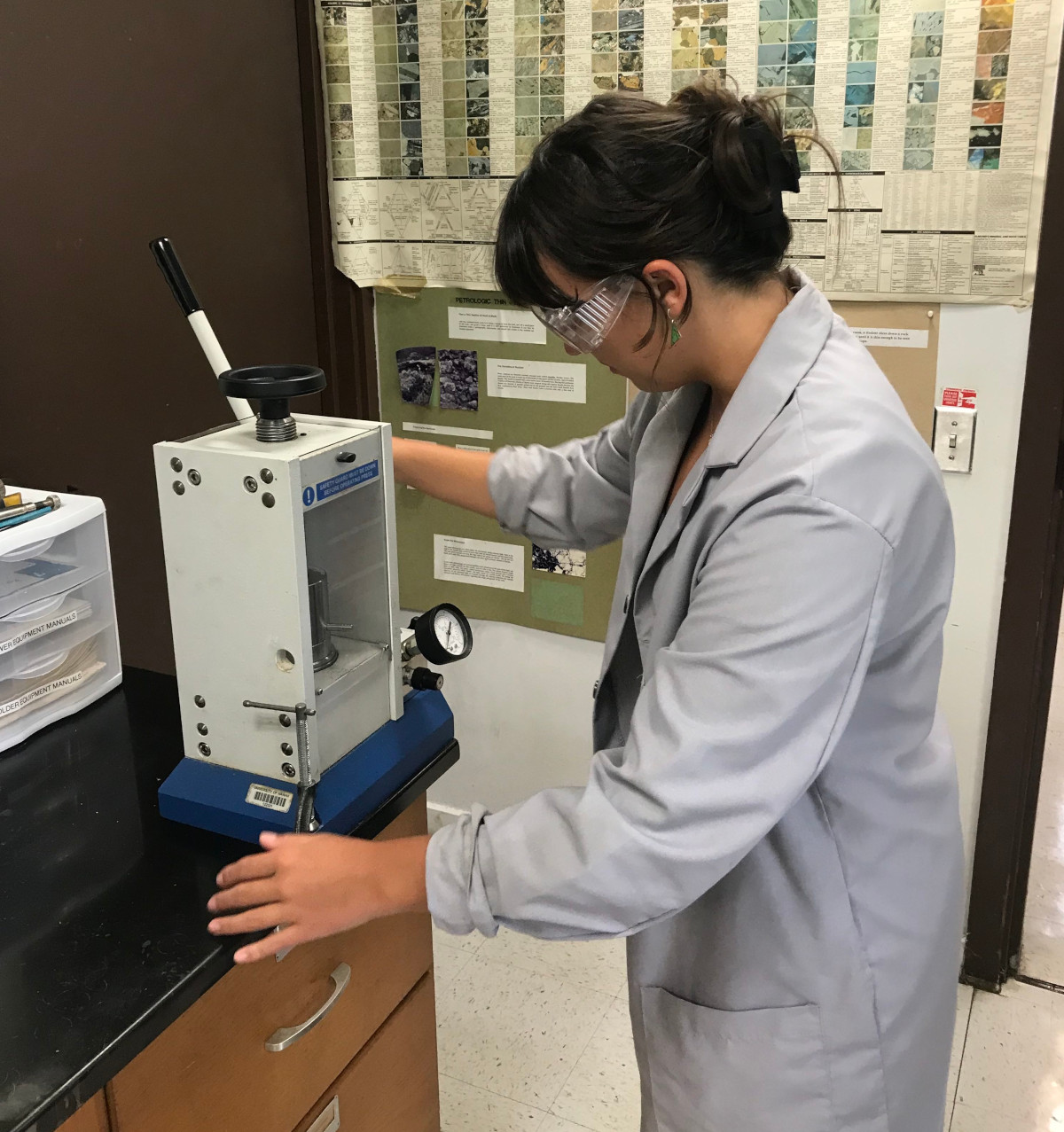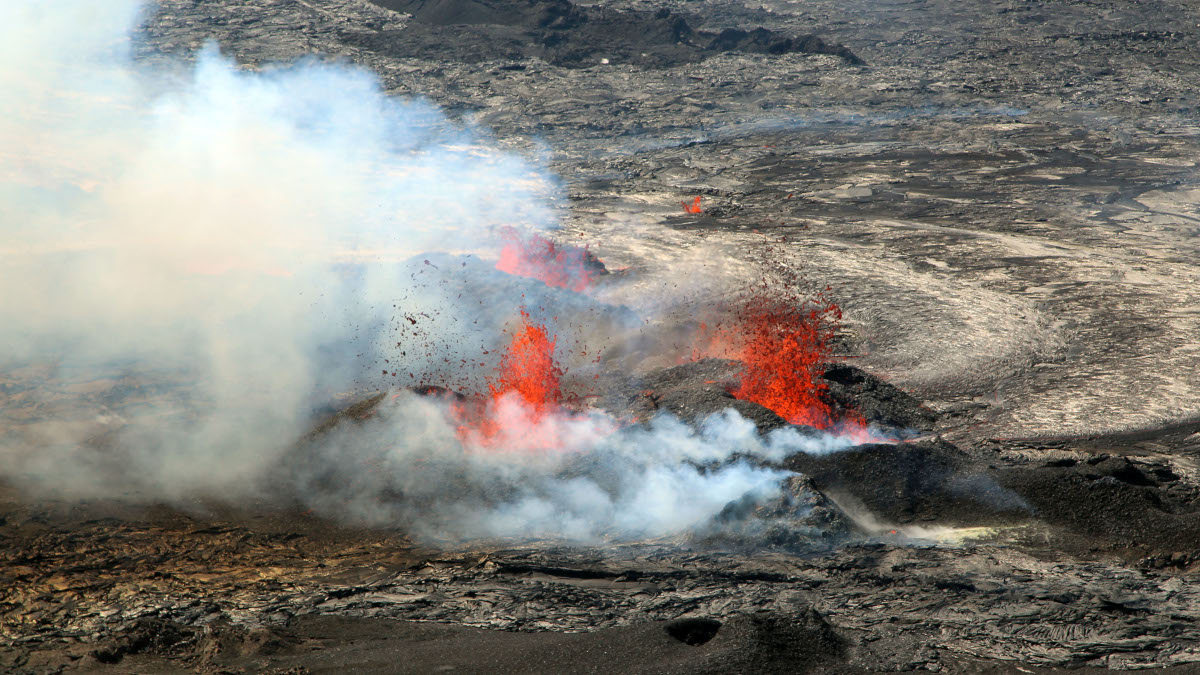
USGS: “HVO geologists collect a molten lava sample near the erupting vents during the morning of September 11, 2023” (USGS photo by M. Patrick).
(BIVN) – The latest summit eruption at Kīlauea continued Friday morning. All activity remains confined to the summit caldera within Hawaiʻi Volcanoes National Park.
From this week’s Volcano Watch article written by U.S. Geological Survey Hawaiian Volcano Observatory scientists and affiliates:
Kīlauea is now erupting at the summit for the fifth time since 2020! The ongoing eruption offers an opportunity for Hawaiian Volcano Observatory (HVO) staff to learn and collaborate with partners at the University of Hawaiʻi at Hilo (UH-Hilo) Geology Department.
Kīlauea eruptions in 2020–2021, 2021–2022, January–March 2023, and June 2023 started and remained within Halemaʻumaʻu crater. The newest eruption that began Sunday, September 10, also started as a lava fountain bursting from within Halemaʻumaʻu.
However, in the minutes to hours immediately following eruption start, vents opened to the east, on the downdropped block that lowered during the 2018 summit collapse. This represents the first lava that has erupted within the summit caldera, but out of Halemaʻumaʻu, in 41 years! In 1982, there were two summit eruptions, both lasting less than one day, that occurred outside of Halemaʻumaʻu.
Since the 2018 summit collapse, eruptions have slowly filled in Halemaʻumaʻu. In fact, the eastern rim of Halemaʻumaʻu is nearly covered with flows originating from the downdropped block. These lava flows are more accessible than those produced during earlier eruptions and geologists were able to collect a molten sample of lava from close to an erupting vent.
HVO works closely with partners at UH-Hilo to quickly analyze eruption samples. What does a day in the life of a lava sample look like as it makes its way from the volcano to ultimately providing information about the nature of the eruption?
When they collect a hot and molten lava sample, HVO scientists quench (cool) it in water. The sample collected on September 11 was driven from the eruption to UH-Hilo, where undergraduate geology research assistants immediately started sample preparation and analysis. First, they dried the sample by putting it in a warm oven for two hours.

USGS: “University of Hawai‘i at Hilo geology major Paige Johnson compresses a lava sample, collected by Hawaiian Volcano Observatory scientists during the ongoing Kīlauea summit eruption, into a solid pellet that can be analyzed.” (UH-Hilo photo by S. Lundblad)
In the early afternoon, a portion of the dried sample was pulverized in a paint-shaker like device called a shatterbox. This process turns the rock into a homogenous powder. The powder was then compressed into a pellet under 25 tons of pressure. The pellet provides a dense, fine-grained, flat surface that can be analyzed for its bulk composition in an instrument called an Energy Dispersive X-Ray Fluorescence Spectrometer (EDXRF), which takes only 20 minutes to complete.
EDXRF uses a small portion of sample, leaving most of the rock for other types of analyses. The chemical composition provided by EDXRF gives a first glimpse of what is happening with the magma during the eruption. Analysis of the sample collected the morning of September 11 was completed less than 24 hours after the eruption began!
Rapid analyses of eruption samples provides valuable information to track eruptions at Kīlauea. The high-quality geochemical characterization that EDXRF analyses offer in near-real-time allows HVO and UH-Hilo geologists to track daily changes in lava chemistry. The partnership between HVO and UH-Hilo began several years before the devastating 2018 lower East Rift Zone eruption but was put to the test during that eruption.
Knowing the compositional changes in the lava samples the very same day they erupted proved critical to understanding changes in lava flow behavior as the 2018 eruption transitioned from cooler, sluggish lava, to hotter, faster-moving lava. This was a valuable tool in assessing the hazard to properties from the advancing lava flows.
Processing eruption samples in a timely manner takes a team. Working together, HVO and UH-Hilo have learned that the temperature and chemistry of lava erupted during this new eruption look very similar to lava from the past four eruptions. This suggests that even if hotter magma from a deeper source is moving into the volcano, it is continuing to mix and cool in a shallower magma body before reaching the surface.
At HVO, scientists collect samples, and other important data about the eruption. At UH-Hilo, faculty and students prepare and analyze the samples. They work together to interpret the compositional data and learn about the processes associated with recent eruptions at Kīlauea.


by Big Island Video News7:05 am
on at
STORY SUMMARY
HAWAIʻI VOLCANOES NATIONAL PARK - This week's Volcano Watch article details how and why - scientists collect and analyze eruption samples.